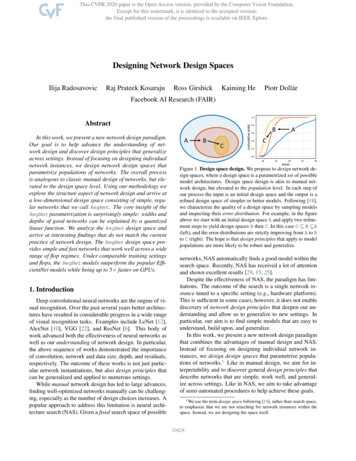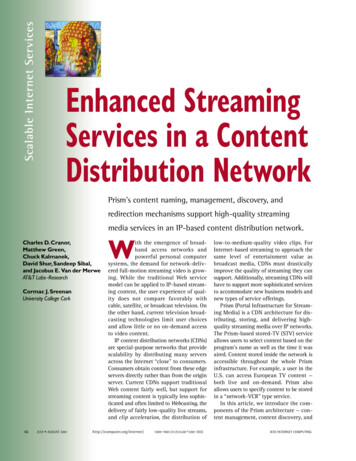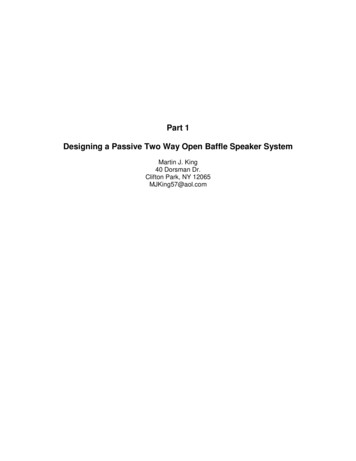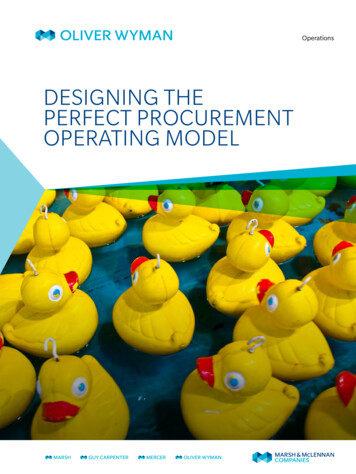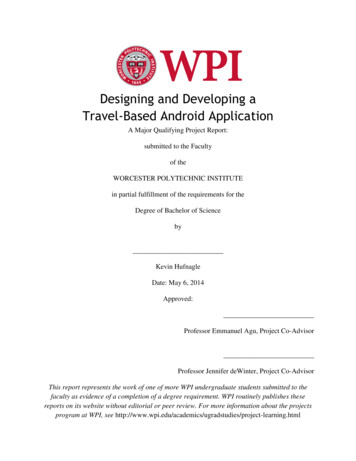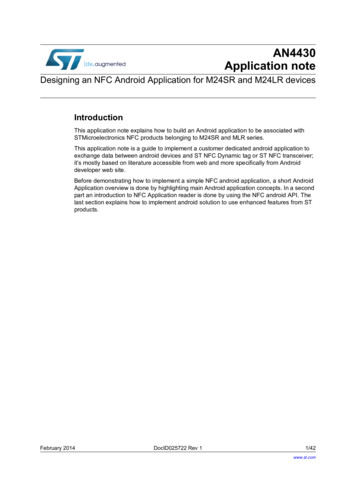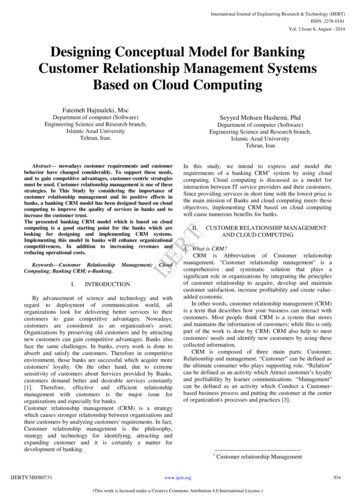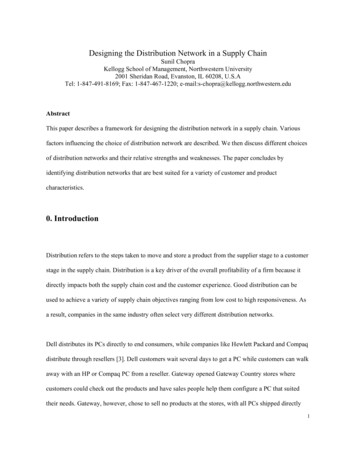
Transcription
Designing the Distribution Network in a Supply ChainSunil ChopraKellogg School of Management, Northwestern University2001 Sheridan Road, Evanston, IL 60208, U.S.ATel: 1-847-491-8169; Fax: 1-847-467-1220; is paper describes a framework for designing the distribution network in a supply chain. Variousfactors influencing the choice of distribution network are described. We then discuss different choicesof distribution networks and their relative strengths and weaknesses. The paper concludes byidentifying distribution networks that are best suited for a variety of customer and productcharacteristics.0. IntroductionDistribution refers to the steps taken to move and store a product from the supplier stage to a customerstage in the supply chain. Distribution is a key driver of the overall profitability of a firm because itdirectly impacts both the supply chain cost and the customer experience. Good distribution can beused to achieve a variety of supply chain objectives ranging from low cost to high responsiveness. Asa result, companies in the same industry often select very different distribution networks.Dell distributes its PCs directly to end consumers, while companies like Hewlett Packard and Compaqdistribute through resellers [3]. Dell customers wait several days to get a PC while customers can walkaway with an HP or Compaq PC from a reseller. Gateway opened Gateway Country stores wherecustomers could check out the products and have sales people help them configure a PC that suitedtheir needs. Gateway, however, chose to sell no products at the stores, with all PCs shipped directly1
from the factory to the customer. In 2001, Gateway closed several of these stores given their poorfinancial performance. Apple Computers is planning to open retail stores where computers will be sold[4]. These PC companies have chosen three different distribution models. How can we evaluate thiswide range of distribution choices? Which ones serve the companies and their customers better?W.W. Grainger, an MRO distributor, stocks about 100,000 skus that can be sent to customers within aday of the order being placed. The remaining slower moving products are not stocked but shippeddirectly from the manufacturer when a customer places an order. It takes several days for the customerto receive the product in this case. Are these distribution choices appropriate? How can they bejustified? When should a distribution network include an additional stage such as a distributor?Proponents of e-business had predicted the death of intermediaries like distributors. Why were theyproved wrong in many industries?In this paper we provide a framework and identify key dimensions along which to evaluate theperformance of any distribution network.1. Factors Influencing Distribution Network DesignAt the highest level, performance of a distribution network should be evaluated along two dimensions:1. Customer needs that are met2. Cost of meeting customer needsThe customer needs that are met influence the company's revenues, which along with cost decide theprofitability of the delivery network.2
While customer service consists of many components, we will focus on those measures that areinfluenced by the structure of the distribution network. These include: Response time Product variety Product availability Customer experience Order visibility ReturnabilityResponse time is the time between when a customer places an order and receives delivery. Productvariety is the number of different products / configurations that a customer desires from thedistribution network. Availability is the probability of having a product in stock when a customerorder arrives. Customer experience includes the ease with which the customer can place and receivetheir order. Order visibility is the ability of the customer to track their order from placement todelivery. Returnability is the ease with which a customer can return unsatisfactory merchandise andthe ability of the network to handle such returns.It may seem at first that a customer always wants the highest level of performance along all thesedimensions. In practice, however, this is not always the case. Customers ordering a book atAmazon.com are willing to wait longer than those that drive to a nearby Borders store to get the samebook. On the other hand, customers can find a far larger variety of books at Amazon compared to theBorders store.3
Firms that target customers who can tolerate a large response time require few locations that may befar from the customer and can focus on increasing the capacity of each location. On the other hand,firms that target customers who value short response times need to locate close to them. These firmsmust have many facilities, with each location having a low capacity. Thus, a decrease in the responsetime customers desire increases the number of facilities required in the network, as shown in Figure4.1. For example, Borders provides its customers with books on the same day but requires about 400stores to achieve this goal for most of the United States. Amazon, on the other hand, takes about aweek to deliver a book to its customers, but only uses about 5 locations to store its Insert Figure 4.1 hanging the distribution network design affects the following supply chain costs: Inventories Transportation Facilities and handling InformationAs the number of facilities in a supply chain increases, the inventory and resulting inventory costs alsoincrease as shown in Figure 4.2. For example, Amazon with fewer facilities is able to turn itsinventory about twelve times a year, while Borders with about 400 facilities achieves only about twoturns per year. As long as inbound transportation economies of scale are maintained, increasing thenumber of facilities decreases total transportation cost, as shown in Figure 4.2. If the number offacilities is increased to a point where there is a significant loss of economies of scale in inboundtransportation, increasing the number of facilities increases total transportation cost. A distribution4
network with more than one warehouse allows Amazon.com to reduce transportation cost relative to anetwork with a single warehouse. Facility costs decrease as the number of facilities is reduced asshown in Figure 4.2, because a consolidation of facilities allows a firm to exploit economies of Insert Figure 4.2 Total logistics costs are the sum of inventory, transportation, and facility costs for a supply chainnetwork. As the number of facilities is increased, total logistics costs first decrease and then increaseas shown in Figure 4.3. Each firm should have at least the number of facilities that minimize totallogistics costs. As a firm wants to further reduce the response time to its customers, it may have toincrease the number of facilities beyond the point that minimizes logistics costs. A firm should addfacilities beyond the cost- minimizing point only if managers are confident that the increase inrevenues because of better responsiveness is greater than the increase in costs because of the ---------------Insert Figure 4.3 2. Design Options for a Distribution NetworkWe will discuss distribution network choices in the context of distribution from the manufacturer tothe end consumer. When considering distribution between any other pair of stages, such as supplier to5
manufacturer, many of the same options still apply. There are two key decisions when designing adistribution network:1. Will product be delivered to the customer location or picked up from a preordained site?2. Will product flow through an intermediary (or intermediate location)?Based on the choices for the two decisions, there are six distinct distribution network designs that areclassified as follows:1. Manufacturer storage with direct shipping2. Manufacturer storage with direct shipping and in-transit merge3. Distributor storage with package carrier delivery4. Distributor storage with last mile delivery5. Manufacturer / distributor storage with costumer pickup6. Retail storage with customer pickupWe now describe each distribution option and discuss its strengths and weaknesses.2.1 Manufacturer Storage with Direct ShippingIn this option, product is shipped directly from the manufacturer to the end customer, bypassing theretailer (who takes the order and initiates the delivery request). This option is also referred to as dropshipping. All inventories are stored at the manufacturer. Information flows from the customer, via theretailer, to the manufacturer, while product is shipped directly from the manufacturer to customers asshown in Figure 4.4. In some instances like Dell, the manufacturer sells directly to the customer.Online retailers such as eBags and Nordstrom.com use drop shipping to deliver goods to the endconsumer. eBags does not hold any inventory of bags and has them drop shipped directly from themanufacturer to the customer. Nordstrom carries some products in inventory while using the drop-ship6
model for slow moving footwear. W.W. Grainger also uses drop shipping to deliver slow movingitems that are not carried in ----Insert Figure 4.4 The biggest advantage of drop shipping is the ability to centralize inventories at the manufacturer. Amanufacturer can aggregate demand and provide a high level of product availability with lower levelsof inventory than individual retailers. The benefits from centralization are highest for high value, lowvolume items with unpredictable demand. The decision of Nordstrom to drop-ship low volume shoessatisfies these criteria. Similarly, bags sold by eBags tend to have high value and low relativelyvolume per sku. The inventory benefits of aggregation are small for items with predictable demandand low value [1]. Thus, drop shipping would not offer a significant inventory advantage to an onlinegrocer selling a staple item like detergent.Drop shipping also offers the manufacturer the opportunity to further lower inventories by postponingcustomization until after the customer order has been placed. Build-to-order companies such as Dellhold inventories as common components and postpone product customization, thus lowering the levelof inventories carried.Transportation costs are high with drop shipping because the average outbound distance to the endconsumer is large and package carriers must be used to ship the product. Package carriers have highshipping costs per unit compared to truckload(TL) or less-than-truckload (LTL) carriers. With dropshipping, a customer order with items from several manufacturers will involve multiple shipments tothe customer. This loss in aggregation in outbound transportation further increases cost.7
Supply chains save on the fixed cost of storage facilities when using drop shipping because allinventories are centralized at the manufacturer. There can be some savings of handling costs as wellbecause the transfer from manufacturer to retailer no longer occurs. Handling costs can besignificantly reduced if the manufacturer has the capability to ship orders directly from the productionline.A good information infrastructure is needed so that the retailer can provide product availabilityinformation to the customer even though the inventory is located at the manufacturer. The customershould also have visibility into order processing at the manufacturer even though the order is placedwith the retailer. Drop shipping will generally require significant investment in the informationinfrastructure. The information infrastructure requirement is somewhat simpler for direct sellers likeDell because two stages (retailer and manufacturer) do not need to be integrated.Response times tend to be large when drop shipping is used because the order has to be transmittedfrom the retailer to the manufacturer and shipping distances are on average longer from themanufacturer's centralized site. eBags, for example, states that order processing may take from 1-5days and ground transportation after that may take from 3-11 business days. This implies thatcustomer response time at eBags is 4-16 days using ground transportation and drop shipping. Anotherissue is that the response time need not be identical for every manufacturer that is part of a customerorder. Given an order containing products from several sources, the customer will receive multiplepartial shipments over time making receiving more complicated for the customer.Manufacturer storage with drop shipping allows a high level of product variety to be made available tothe customer. W.W. Grainger is able to offer hundreds of thousands of slow moving items from8
thousands of manufacturers using drop shipping. This would be impossible if each product had to bestored by Grainger.Drop shipping provides a good customer experience in the form of delivery to the customer location.The experience, however, suffers when a single order containing products from several manufacturersis delivered in partial shipments.Order visibility is very important in the context of manufacturer storage because two stages in thesupply chain are involved in every customer order. Order tracking, however, becomes harder toimplement in a situation of drop shipping because it requires complete integration of informationsystems at both the retailer as well as the manufacturer. For direct sellers such as Dell, order visibilityis simpler to provide.A manufacturer storage network is likely to have difficulty handling returns, hurting customersatisfaction. The handling of returns is more expensive under
Designing the Distribution Network in a Supply Chain Sunil Chopra Kellogg School of Management, Northwestern University 2001 Sheridan Road, Evanston, IL 60208, U.S.A Tel: 1-847-491-8169; Fax: 1-847-467-1220; e-mail:s-chopra@kellogg.northwestern.edu Abstract This paper describes a framework for designing the distribution network in a supply chain. Various

